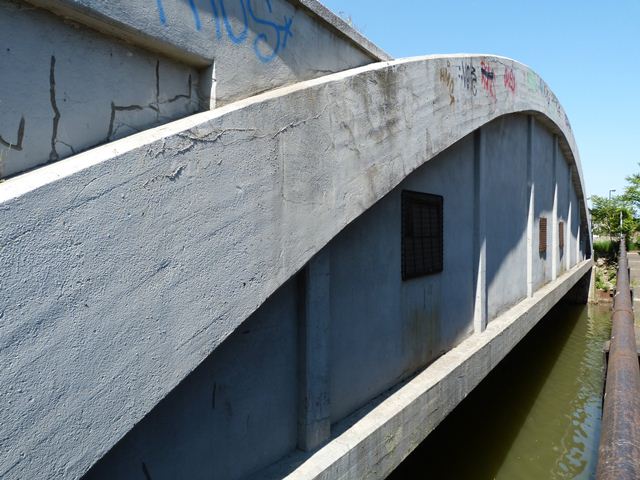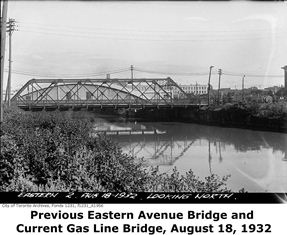We Recommend:
Bach Steel - Experts at historic truss bridge restoration.
BridgeHunter.com Phase 1 is released to the public! - Visit Now
Gas Line Bridge
Consumers Gas Company Bridge

Primary Photographer(s): Nathan Holth
Bridge Documented: June 20, 2013 and April 8, 2018
Not Available or Not Applicable
133.0 Feet (40.5 Meters)
133.0 Feet (40.5 Meters)
Not Available
1 Main Span(s)
Not Applicable

View Information About HSR Ratings
Bridge Documentation
This bridge's future is at risk!
Bridge Status: This heritage bridge is slated for demolition in 2022 as part of the Broadview and Eastern Flood Protection Project!This bridge is right next to the Eastern Avenue Bridge.
This bridge is a very unusual structure, that is only really a "bridge" in the common sense of the term because it crosses something, that being the Don River, and also because its load-bearing structure takes a form commonly used in bridge design, that of the concrete arch. The structure does not carry traffic of any kind, and actually is an enclosed building complete with windows, doors, and an air vent on the roof. Its purpose is to carry a gas pipeline over the river. Pipeline bridges are not as common as traffic bridges, but they are not uncommon either. There are different reasons why a pipeline might need its own bridge rather than being attached to a traffic bridge as is often the case. There may not be a bridge nearby, for example. In the case of this bridge, the reason for the separate structure was apparently because this gas pipe was so large it was considered too heavy for the highway bridge that stood here at the time it was built. This refers to the previous Eastern Avenue Bridge at the location, not the one standing next to it today. That assessment was perhaps wise, since the old Eastern Avenue Bridge collapsed a few years after this Gas Line Bridge was completed. What is most unusual about the Gas Pipe Bridge however is its structural design. Usually pipeline bridges simply carry the pipeline out in the open, not inside an elaborate building as is the case here. Moreover, the concrete through arch design is unusual. Most pipeline bridges are a truss, beam, girder, or suspension bridge structure.
This bridge was not the first Gas Line Bridge at this location. The original bridge that preceded this bridge was built sometime after 1900. It was constructed by Consumers Gas Company to carry coal gas, which the company supplied to the city from three different plans including one on Eastern Avenue near Booth Avenue. The first bridge structure was a rivet-connected double-intersection Warren through truss. Like the current bridge, this bridge also had a building structure that completely enclosed the pipeline. This bridge collapsed in 1929, which led to the construction of the current concrete bridge. Today, the bridge remains a functional structure since Enbridge uses the pipleline to carry natural gas.
Above: These photos show the collapse of the previous Gas Line Bridge.
This bridge is tagged with the following special condition(s): Unorganized Photos
![]()
Photo Galleries and Videos: Gas Line Bridge
Bridge Photo-Documentation
Original / Full Size PhotosA collection of overview and detail photos. This gallery offers photos in the highest available resolution and file size in a touch-friendly popup viewer.
Alternatively, Browse Without Using Viewer
![]()
Bridge Photo-Documentation
Mobile Optimized PhotosA collection of overview and detail photos. This gallery features data-friendly, fast-loading photos in a touch-friendly popup viewer.
Alternatively, Browse Without Using Viewer
![]()
Additional Unorganized Photos
Original / Full Size PhotosA supplemental collection of photos that are from additional visit(s) to the bridge and have not been organized or captioned. This gallery offers photos in the highest available resolution and file size in a touch-friendly popup viewer.
Alternatively, Browse Without Using Viewer
![]()
Additional Unorganized Photos
Mobile Optimized PhotosA supplemental collection of photos that are from additional visit(s) to the bridge and have not been organized or captioned. This gallery features data-friendly, fast-loading photos in a touch-friendly popup viewer.
Alternatively, Browse Without Using Viewer
![]()
Maps and Links: Gas Line Bridge
Coordinates (Latitude, Longitude):
Search For Additional Bridge Listings:
Additional Maps:
Google Streetview (If Available)
GeoHack (Additional Links and Coordinates)
Apple Maps (Via DuckDuckGo Search)
Apple Maps (Apple devices only)
Android: Open Location In Your Map or GPS App
Flickr Gallery (Find Nearby Photos)
Wikimedia Commons (Find Nearby Photos)
Directions Via Sygic For Android
Directions Via Sygic For iOS and Android Dolphin Browser








